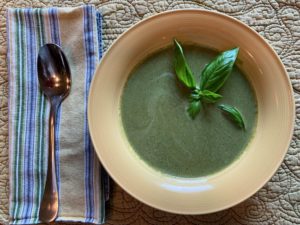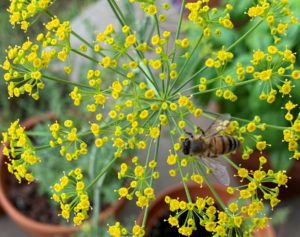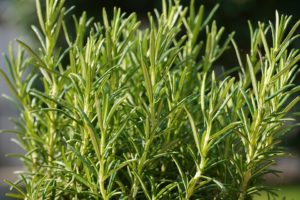Thyme, a member of the mint family, is considered a perennial herb in most zones. It has small leaves and woody stems. Like lavender, thyme originated in the Mediterranean, so it is no surprise that it thrives in warm, sunny climates. It is considered low maintenance and a great addition to any garden. What’s more, thyme’s aroma and flavor add a savory element to soups, vegetables, sauces, and meats.
This article contains affiliate links. If you make a purchase using one of these links, I will receive a very small commission at no additional cost to you, and it will help me maintain this website. Rest assured, I only recommend products I actually like!
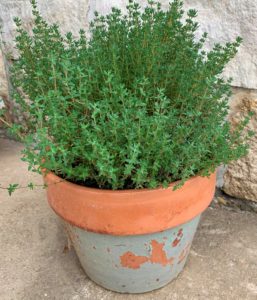
I first fell in love with thyme when I discovered the many medicinal uses its essential oil has. According to one recent scientific publication, thyme “exhibits antimicrobial, antioxidant, anticarcinogenesis, anti-inflammatory, and antispasmodic activities.”[1] (If you are interested, this is the thyme essential oil that I use.) Its usefulness inspired me to grow it in my container garden. Now, I can cut off a fresh sprig whenever I need it.
How to Plant Thyme
Most varieties of thyme can be grown in zones 5 through 9 because it easily adapts to its environment. If you’re going to direct sow, plant thyme seeds one to two weeks after your average last frost date when the temperature of the soil is between 70 and 80 F. If you are going to start seeds indoors under a grow light, you can do so between 6 and 8 weeks before your average last frost date. (If you are unsure about your area’s frost dates, you can find a link listed on my Resources page under Helpful Gardening Links that will provide you with that information.)
Depending on the variety, you’ll need to space the plants about 10 inches to 12 inches apart, with some varieties requiring more space. Expect the plants to reach a height of between 6 inches and 12 inches. Like carrot seeds, thyme seeds should be sown only 1/8 inch deep with soil scattered loosely on top. Water gently so as not to dislodge the seeds.
Some report difficulty in growing thyme from seed, but it could be because they aren’t aware that it can take two to four weeks, or longer, for the seeds to germinate. The key is to give the seeds everything they need to grow, including patience.
Once the seedlings reach between 1 and 2 inches in height, thin them to one sprout every 12 inches. They are ready to transplant when they are about 6 inches tall.
Thyme produces beautiful white, pink, or lavender blooms in the spring and summer months. The flowers are a favorite of pollinators.
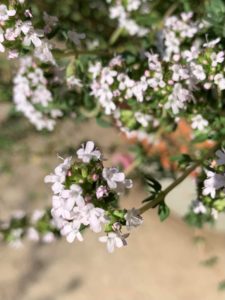
Sun, Soil, Water, and Fertilizer
Thyme does not require as much TLC as some herbs like basil do. But it does need good draining soil to prevent root rot. In addition, it requires six hours of full sun. Like oregano and rosemary, this herb actually thrives in warm, dry conditions. Allow the top few inches of soil to dry out, then water it thoroughly.
This low maintenance herb does not require much fertilizer. In fact, too much fertilizer can alter its flavor and fragrance. However, if you grow thyme in containers, you may want to use a gentile liquid fertilizer like the one I use to help replace nutrients that will wash out of the container over time. Once a month during the growing season should be fine.
How to Propagate Thyme
Since some find starting thyme from seed to be challenging, another option would be to purchase a starter plant from one of the box stores or your local nursery. Once it grows to a height of six inches or more, you can divide it into two plants. Just make sure there is a root ball for each section.
Another way to multiply your thyme is to take cuttings from the plant and propagate them in water. Start by cutting a younger, and therefore, less woody sprig that is about 6 inches long. Remove the lower sets of leaves and place it in a container of water. Change the water every few days. It may take several weeks, but once the roots are at least an inch or so long, you can transplant the sprig to well-draining soil. Be careful when you transplant it as the roots can easily break off.
Alternatively, instead of developing the roots in water, you can place the cutting directly into the soil. You can dip it in a rooting hormone that will stimulate growth, but it is not necessary. Planting directly into the soil instead of first growing the roots in water may take a bit longer for the cutting to get established, so be patient.
How to Harvest
Summer is the optimum time to harvest thyme, preferably before it flowers. If you see flower buds starting to develop, you can pinch them off to prolong the harvest season. However, some claim the leaves will retain their flavor even after the plant has flowered. Like other herbs, the more you harvest, the more it will grow. Just remember to leave new growth and refrain from removing more than 1/3 of the plant.
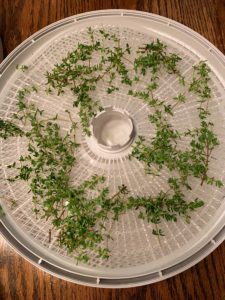
Thyme can be stored in the refrigerator in a plastic bag or similar container for several days. To preserve the harvest for a longer period of time, you can dry it in a dehydrator like the one I have or in the oven on its lowest setting. You can also tie sprigs together and hang them in a dark, well-ventilated area. Once dried, remove the leaves from the stems and store them in an airtight container.
Another way to preserve thyme is by placing the harvested leaves in olive oil in an ice cube tray. Remove the individual cubes from the freezer when needed.
Overwintering
Thyme will go dormant during the winter months. If you live in a cold climate, add a layer of mulch around the plant to help protect it. In the spring, prune any dead branches, and new growth should appear before long.
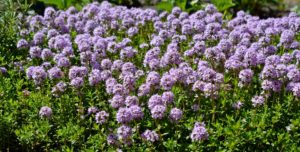
Pests and Diseases
One reason thyme is considered a low maintenance herb is because it is relatively pest and disease-free. The most common problem associated with thyme is root rot, which is a fungus characterized by yellow leaves and wilting stems. Root rot is caused by overwatering or poorly draining soil. To determine if it is root rot, extract a portion of the plant to examine the root. If it looks rotten, diseased, or soggy, then there’s a good probability it has root rot. You will need to remove the plant and destroy it so that the fungus does not spread to the rest of your plants. Do not compost the infected plants.
Some advise that if you catch root rot early, you may be able to save your plant by digging it up and trimming the roots that are affected. Replant it in a clean pot with new soil and be careful not to overwater. Be sure to clean the tools you used so as not to spread the fungus to healthy plants. (You can learn more about how to sanitize garden tools in this helpful article.)
As for pests, aphids and spider mites will sometimes target thyme, but these can be easily treated organically.
Pest Repellent
Thyme, like rosemary and other strongly scented herbs, has been known to repel certain insects. For example, thyme planted throughout your garden is said to repel cabbage loopers, slugs, corn earworms, tomato hornworms, mosquitoes, and whiteflies.
Varieties
The more than three hundred varieties of thyme can be categorized into three primary groups: those that grow upright, those that clump or mound, and those that creep and are used for ground cover.
The most common varieties used in cooking are English thyme, French thyme, and Lemon thyme. English thyme, which grows to a height of about 12 to 16 inches, has white or lavender blossoms. French thyme grows to about 12 inches, has lavender blossoms, and is said to have a softer flavor than English thyme. Lemon thyme has a strong lemon aroma and grows to about 12 inches.

Varieties better suited as ornamentals or ground cover are woolly thyme and creeping thyme. Woolly thyme is a soft, cascading carpet-like variety that has no real scent. Creeping thyme has a milder scent, grows to a height of only a few inches, and has white, pink, or purple flowers.
If you are looking for a low maintenance, disease and pest resistant herb to grow in your garden, consider planting thyme. It is beautiful to look at, and it has a variety of uses that make it a worthwhile addition.
Thank you for reading this article! If you found it helpful, please consider sharing it with others on social media!
[1] https://pubmed.ncbi.nlm.nih.gov/29785774/

